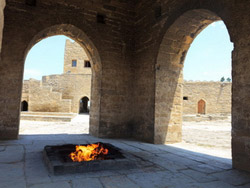Ateshgah Temple

Along with other monuments of old Baku, the Ateshgah Fire Temple is of great interest. This unique monument of antiquity gives the most complete picture of the followers of the ancient religion of Zoroastrianism. It is located thirty kilometers from the center of Baku, on the southeastern outskirts of the village of Surakhany on the Absheron Peninsula. The temple of Zoroastrians — fire worshippers was built on the site of burning natural gas outlets and dates back to the XVII-XVIII centuries. Zoroastrians came here to worship the sacred fire.
It is believed that the first temple was built at the beginning of our era. However, the most recent is the main temple-the altar, erected, as the inscription says, at the expense of the merchant Kanchanagar in 1810. During the XVIII century, chapels, cells, and caravanserai grew up around the sanctuary, being attached to each other. On the cells of the monument there are inscriptions carved on stone, executed in the fonts of the Indian script — davanagari and gumruki.
Numerous monks who lived in Ateshgah worshiped fire, led a reclusive lifestyle, injuring themselves, they believed that in this way they purify their soul. Hermits hung thirty kilogram chains on themselves, lay on quicklime — until the necrosis of individual parts of the body.
They did not work, they lived off the donations of Indian merchants. Hermits believed that the human soul after death is reborn and returns to Earth again. And in what guise — a noble person or some animal - depends on karma — the sum of good and evil deeds.
Today Oteshgah is one of the most popular monuments of antiquity, which is of great interest to travelers. Representatives of various faiths come here. Muslims offer sacrifices, Hindus and fire worshippers pray.

Baku - Sights of Interest
- Magomaev Azerbaijan State Philharmonic Hall
- Absheron Towers
- Gobustan
- Mud Volcanoes
- Shirvanshah`s Palace
- Maiden`s Tower (Qiz Qalasi)
- Ichari-Shahar (The Old City)
- Svjatih Zhen Mironosic Cathedral
- Sinik-Kala Mosque
- Tuba-Shahi Mosque
- Kerimov Museum of Carpet and National Applied Art
- Sabail Castle
- Kala Settlement
- Ateshgah Temple